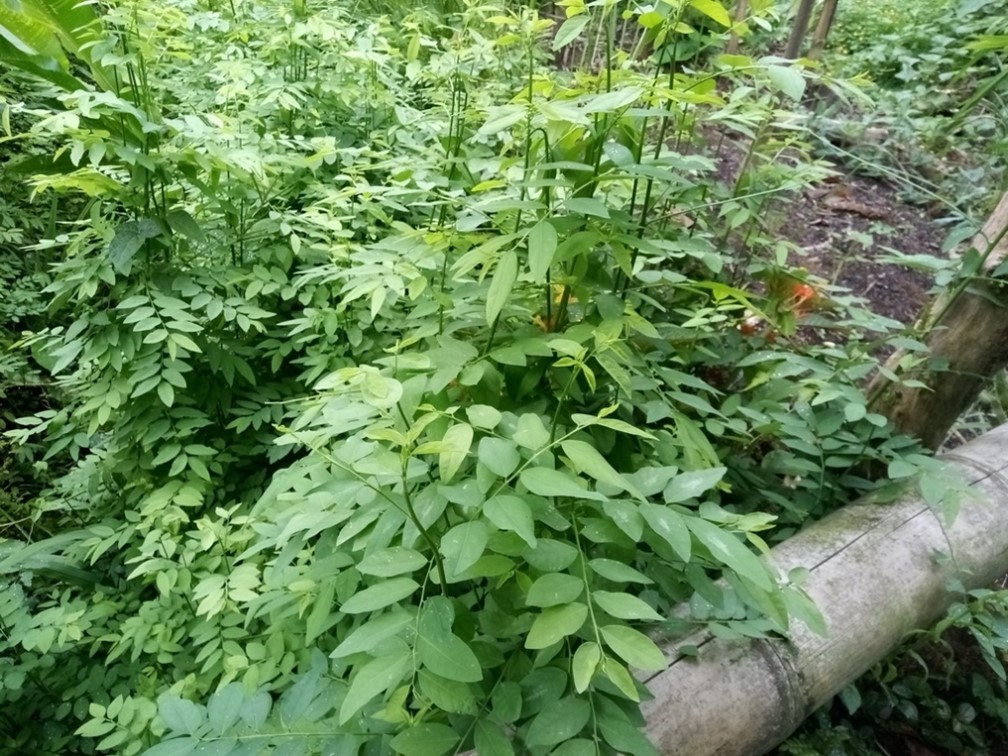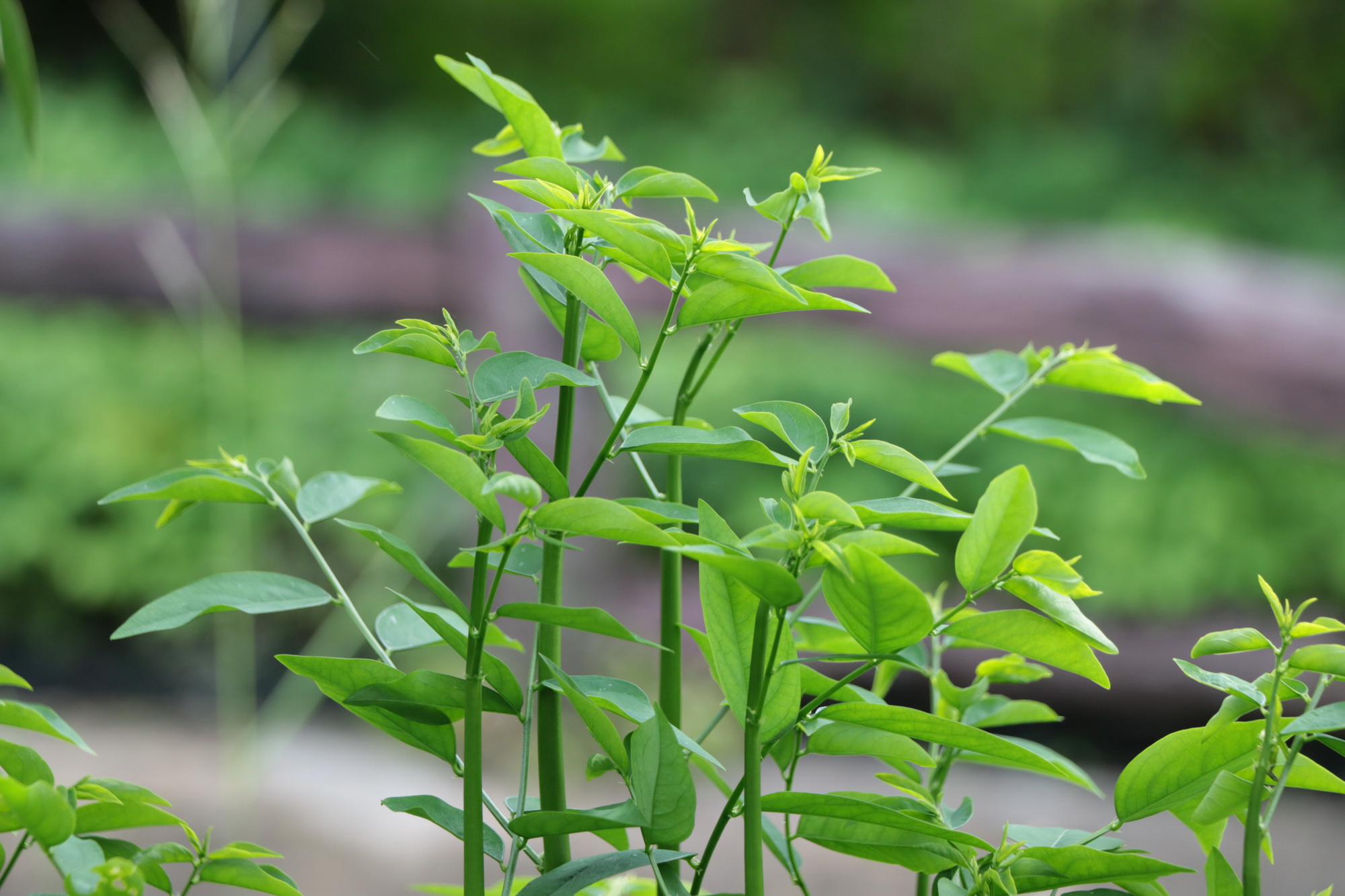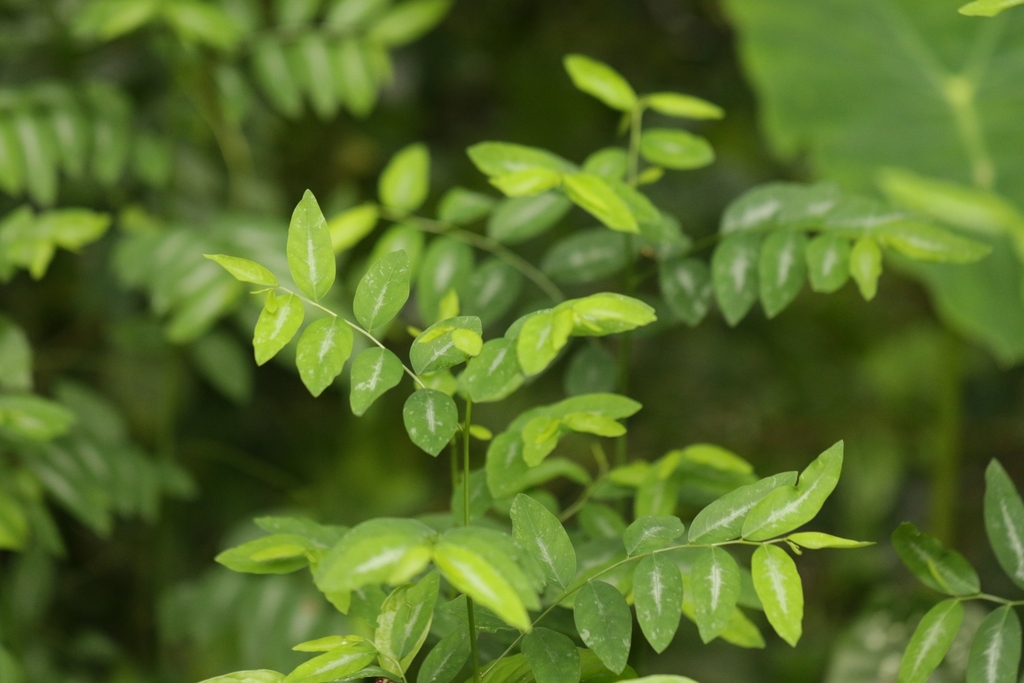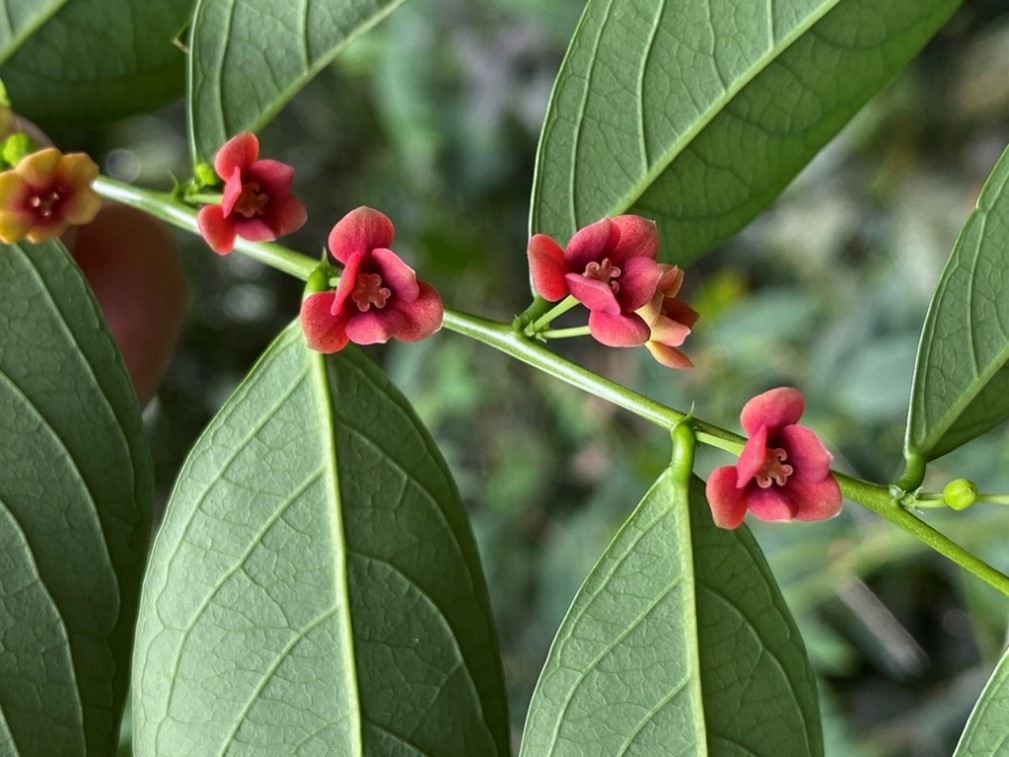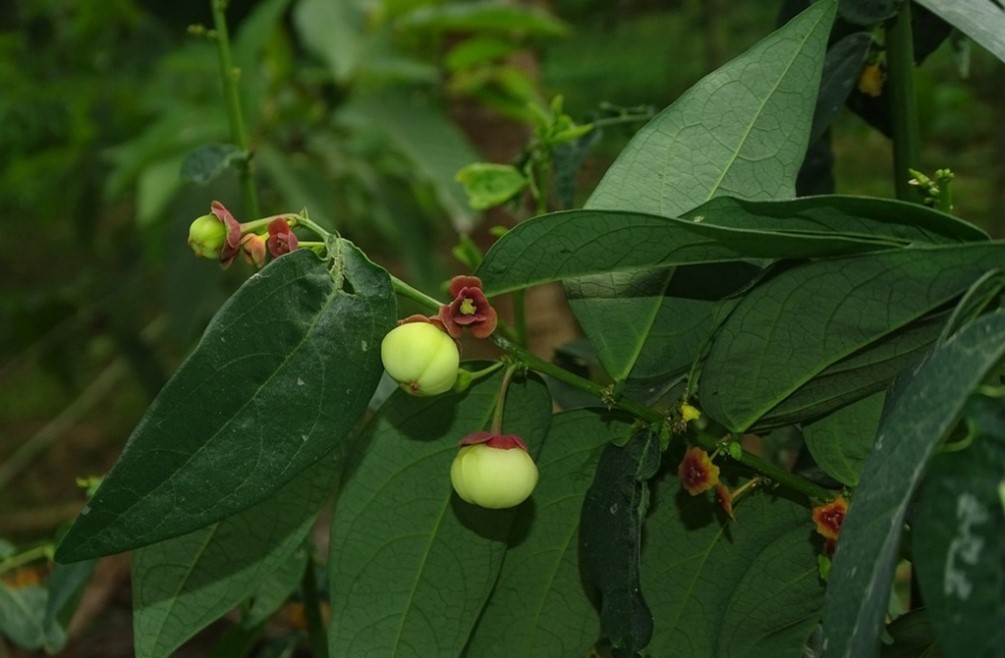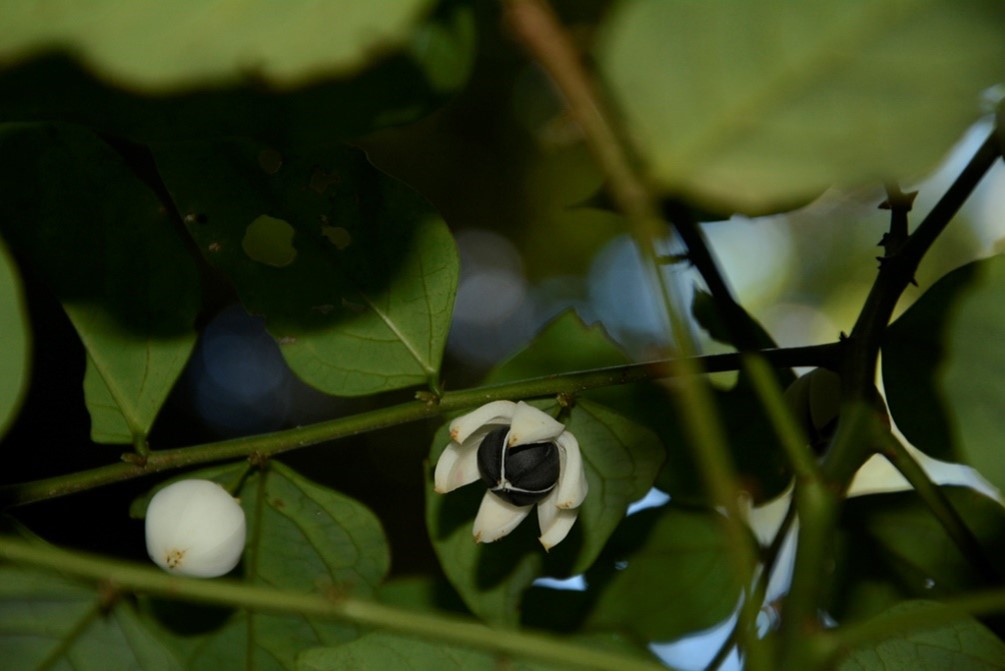ເລກລຳດັບທີ: 786
ລະດັບການຮວບຮວມຂໍ້ມູນ: ເກີອບສົມບູນ
ປັບປູງຄັ້ງລ່າສຸດ: 2024-10-18
ຜັກຫວານບ້ານ
Cekur Manis
Breynia androgyna (L.) Chakrab. & N.P.Balakr.
ພືດ
ໄມ້ຢືນຕົ້ນ
ໄມ້ພຸ່ມ
×
ຊື່ທ້ອງຖີ່ນ:
ຜັກຫວານ ( Chekur Manis, Cekuk Manis, Sayur Manis, Pucuk Manis, Star Gooseberry, Sweet Leaf Bush, Katuk)
ຊື່ພ້ອງ
:
Aalius androgyna (L.) Kuntze
Aalius oblongifolia (Hook.f.) Kuntze
Aalius sumatrana (Miq.) Kuntze
Agyneia ovata Poir.
Andrachne ovata Lam.
Andrachne ovata Lam. ex Poir.
Clutia androgyna L.
Phyllanthus acidissimus Noronha
Phyllanthus androgynus (L.) Chakrab. & N.P.Balakr.
Phyllanthus androgynus (L.) J.A.González
Phyllanthus speciosus Noronha
Phyllanthus strictus Roxb.
Sauropus albicans Blume
Sauropus albicans var. gardnerianus (Wight) Müll.Arg.
Sauropus albicans var. genuinus Müll.Arg.
Sauropus albicans var. intermedius Müll.Arg.
Sauropus albicans var. zeylanicus (Wight) Müll.Arg.
Sauropus androgynus (L.) Merr.
Sauropus convexus J.J.Sm.
Sauropus gardnerianus Wight
Sauropus indicus Wight
Sauropus macranthus Fern.-Vill.
Sauropus oblongifolius Hook.f.
Sauropus parviflorus Pax & K.Hoffm.
Sauropus scandens C.B.Rob.
Sauropus sumatranus Miq.
Sauropus zeylanicus Wight
Aalius oblongifolia (Hook.f.) Kuntze
Aalius sumatrana (Miq.) Kuntze
Agyneia ovata Poir.
Andrachne ovata Lam.
Andrachne ovata Lam. ex Poir.
Clutia androgyna L.
Phyllanthus acidissimus Noronha
Phyllanthus androgynus (L.) Chakrab. & N.P.Balakr.
Phyllanthus androgynus (L.) J.A.González
Phyllanthus speciosus Noronha
Phyllanthus strictus Roxb.
Sauropus albicans Blume
Sauropus albicans var. gardnerianus (Wight) Müll.Arg.
Sauropus albicans var. genuinus Müll.Arg.
Sauropus albicans var. intermedius Müll.Arg.
Sauropus albicans var. zeylanicus (Wight) Müll.Arg.
Sauropus androgynus (L.) Merr.
Sauropus convexus J.J.Sm.
Sauropus gardnerianus Wight
Sauropus indicus Wight
Sauropus macranthus Fern.-Vill.
Sauropus oblongifolius Hook.f.
Sauropus parviflorus Pax & K.Hoffm.
Sauropus scandens C.B.Rob.
Sauropus sumatranus Miq.
Sauropus zeylanicus Wight
ຊື່ສະກຸນ:
Phyllanthaceae
ຊະນິດໃກ້ຄຽງ:
ຜັກຫວານປ່າ/ Melientha
ໄຄ້ຂົມ/ Mekong curry flower
ໄຄ້ຂົມ/ Mekong curry flower
ບັນຍາຍລັກສະນະທາງພືດສາດ:
ຜັກຫວານເປັນໄມ້ຟຸ່ມສູງທີ່ມີລຳຕົ້ນດຽວ, ສູງຮອດ 3 ມ. ໃບດ່ຽວ. ອອກຮຽງສະຫຼັບ, ຮູບຫອກແຄບ ຫຼື ຮູບຂອບຂະໜານ, ມີຄວາມຍາວ 2 ຫາ 7 ຊມ. ແລະ ກວ້າງ 1 ຫາ 3 ຊມ. ຂອບລຽບ, ຜິວໃບດ້ານເທິງມີສີຂຽວເຂັ້ມກ່ວາຜິວໃບດ້ານລຸ່ມ.
ດອກແຍກເພດ, ດອກເພດແມ່ຈະອອກເປັນກຸ່ມ, ແຕ່ດອກເພດຜູ້ຈະອອກໃຕ້ກິ່ງ, ກ້ານດອກເພດຜູ້ຮຽວຍາວປະມານ 5 ຫາ 7 ຊມ. ກາບດອກຕື້ນ ແລະ ມີຍັກ, ດອກມີສີຫຼືອງ, ເສັ້ນຜ່າສູນກາງ 5 ຫາ 12 ຊມ. ກີບດອກຮູບໄຂ່, ກີບດອກມີ 6 ກີບ, ໂຄງເຂົ້າດ້ານໃນເພື່ອປົກປ້້ອງລະອອງເກສອນ, ເກສອນເພດຜູ້ມີ 3 ອັນ, ກ້ານເກສອນເຊື່ອມຕິດກັນ ແລະ ຖົງລະອອງເກສອນເຊື່ອມຕິດກັນ ແລະ ຊີ້ໄປທາງຂວາ.
ກ້ານດອກເພດແມ່ມີຄວາມຍາວ 6 ຫາ 8 ມມ. ກາບດອກເພດແມ່ມີຄວາມຍາວ 6 ຫາ 8 ມມ. ກາບດອກເພດແມ່ເປັນສີແດງ ແລະ ມີ 6 ກີບ, ຮູບໄຂ່ ແລະ ເປັນຮູບສາມຫຼ່ຽມ. ໂດຍໂຄນກີບດອກຈະແຄບລົງ, ສັ້ນ. ເຕົ້າໄຂ່ແບ່ງອອກເປັນ 3 ຫ້ອງ ແລະ ພັດທະນາເປັນໝາກສີຂາວ ຫາ ສີບົວ. ເຊິ່ງເປີດອອກດ້ວຍເປືອກບາງໆ 3 ແສກ.
ແຫຼ່ງທີ່ມາ: [1]
ດອກແຍກເພດ, ດອກເພດແມ່ຈະອອກເປັນກຸ່ມ, ແຕ່ດອກເພດຜູ້ຈະອອກໃຕ້ກິ່ງ, ກ້ານດອກເພດຜູ້ຮຽວຍາວປະມານ 5 ຫາ 7 ຊມ. ກາບດອກຕື້ນ ແລະ ມີຍັກ, ດອກມີສີຫຼືອງ, ເສັ້ນຜ່າສູນກາງ 5 ຫາ 12 ຊມ. ກີບດອກຮູບໄຂ່, ກີບດອກມີ 6 ກີບ, ໂຄງເຂົ້າດ້ານໃນເພື່ອປົກປ້້ອງລະອອງເກສອນ, ເກສອນເພດຜູ້ມີ 3 ອັນ, ກ້ານເກສອນເຊື່ອມຕິດກັນ ແລະ ຖົງລະອອງເກສອນເຊື່ອມຕິດກັນ ແລະ ຊີ້ໄປທາງຂວາ.
ກ້ານດອກເພດແມ່ມີຄວາມຍາວ 6 ຫາ 8 ມມ. ກາບດອກເພດແມ່ມີຄວາມຍາວ 6 ຫາ 8 ມມ. ກາບດອກເພດແມ່ເປັນສີແດງ ແລະ ມີ 6 ກີບ, ຮູບໄຂ່ ແລະ ເປັນຮູບສາມຫຼ່ຽມ. ໂດຍໂຄນກີບດອກຈະແຄບລົງ, ສັ້ນ. ເຕົ້າໄຂ່ແບ່ງອອກເປັນ 3 ຫ້ອງ ແລະ ພັດທະນາເປັນໝາກສີຂາວ ຫາ ສີບົວ. ເຊິ່ງເປີດອອກດ້ວຍເປືອກບາງໆ 3 ແສກ.
ແຫຼ່ງທີ່ມາ: [1]
ນິເວດວິທະຍາ
ເຂດກະຈາຍພັນທົ່ວໂລກ:
Australia, Bangladesh, Bhutan, Brunei Darussalam, Cambodia, China, Hong Kong, India, Indonesia, Lao People's Democratic Republic, Malaysia, Myanmar, Nepal, Papua New Guinea, Philippines, Sri Lanka, Thailand, Viet Nam
Global distribution of Cekur Manis between 2004 to 2024. Source: [5]
Global distribution of Cekur Manis between 2004 to 2024. Source: [5]
ເຂດກະຈາຍພັນໃນລາວ
:
ເຂດພູສູງສາຍພູຫຼວງ ແລະ ເຂດພູພຽງແຂວງຊຽງຂວາງ
ເຂດສາຍພູຫຼວງພາກເໜືອ
ເຂດລຽບແມ່ນ້ຳຂອງພາກໃຕ້
ເຂດສາຍພູຫຼວງພາກເໜືອ
ເຂດລຽບແມ່ນ້ຳຂອງພາກໃຕ້

ເຂດກະຈາຍພັນຕາມພູມສັນຖານ
:
ປ່າດົງດິບ
ປ່າປະສົມປ່ຽນໃບ
ປ່າປູກ
ປ່າເຫຼົ່າແກ່
ເຂດຊຸມຊົນ
ປ່າປະສົມປ່ຽນໃບ
ປ່າປູກ
ປ່າເຫຼົ່າແກ່
ເຂດຊຸມຊົນ
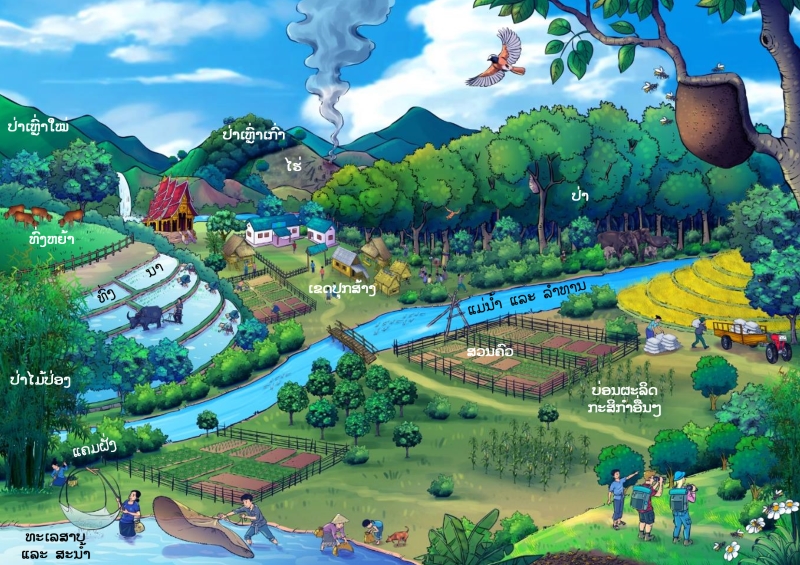
ສະເພາະຖິ່ນໃນລາວ:
ພື້ນເມືອງ
ຮຸກຮານ
:
ບໍ່ຮຸກຮານ
ສະຖານະພາບການອະນູຮັກ IUCN
:
ມີຄວາມສ່ຽງໜ້ອຍສຸດ
ສະຖານະພາບການອະນຸຮັກແຫ່ງຊາດລາວ
:
ບໍ່ຖືກລະບຸໃນບັນຊີປະເພດໃດ
ການນຳໃຊ້
ປະເພດການນຳໃຊ້:
ອາຫານ
ພືດເປັນຢາ
ພືດເປັນຢາ
ບັນຍາຍການນຳໃຊ້:
ອາຫານ: ໃນອາຊີຕາເວັນອອກສ່ຽງໃຕ້ ສ່ວນຕ່າງໆຂອງພືດ ລວມທັງໃບ, ລຳຕົ້ນ, ດອກ ແລະ ໝາກອອ່ນ, ມັກນຳມາຮັບປະທານເປັນຜັກ ໂດຍປຸ່ງດ້ວຍວິທີ່ການຕ່າງໆ ເຊັ່ນ: ຂົ້ວ, ຕົ້ມ ຫຼື ໜື້ງ [4]. ໃບສາມາດນຳມາຮັບປະທານໄດ້ບໍ່ວ່າຈະດິບ ຫຼື ສຸກ ແລະ ມັກຈະໃຊໃນແກງ ຫຼື ແຕ່ງກິນກັບເຂົ້າ, ໝາກສຸກໃຊ້ເປັນເຂົ້າໜົມ ແລະ ໃບໃຊ້ຍ້ອມສີຂຽວ ທີ່ເໝາະສົມສຳຫຼັບແຕ່ງສີອາຫານ. [3]
ສະມຸນໄພ: ໃນອາຊີໃຕ້, ອາຊີຕາເວັນອອກສ່ຽງໃຕ້ ແລະ ຈີນ ພືດຊະນິດນີ້ຖືເປັນຢາສະໝຸນໄພ ທີ່ໄດ້ຮັບຄວາມນິຍົມໃນການຮັກສາບັນຫາສຸຂະພາບຕ່າງໆ ເຊັ່ນ ຄວາມດັນເລືອດສູງ, ເບົາຫວານ, ການສູນເສຍການເບິ່ງເຫັນ ແລະ ອາການຜິດປົກກະຕິຂອງລະບົບທາງເດີນອາຫານ ແລະ ທາງເດີນປັດສະວະ, ນອກຈາກນີ້ ພືດຊະນີ້ຍັງຊ່ວຍກະຕຸ້ນການຜະລິດນ້ຳນົມ ຊ່ວຍຫຼຸດນ້ຳໜັກ ແລະ ຊ່ວຍຮັກສາແຜ. ການສຶກສາໃນຫ້ອງທົດລອງໄດ້ພິສູດວ່າ ພືດຊະນິດນີ້ມີປະໂຫຍດທາງການແພດບາງປະການ ເຊັ່ນ ມີລິດຕ້ານເຊື້ອຈຸລິນຊີ ແລະ ຕ້ານການອັກເສບ [4]. ໃໃຊ້ເປັນຢາກແ້ໄອ, ບັນເທົາອາການໄອໃນປອດ ແລະ ຮັກສາໄຂ້ພາຍໃນ. [3]
ສະມຸນໄພ: ໃນອາຊີໃຕ້, ອາຊີຕາເວັນອອກສ່ຽງໃຕ້ ແລະ ຈີນ ພືດຊະນິດນີ້ຖືເປັນຢາສະໝຸນໄພ ທີ່ໄດ້ຮັບຄວາມນິຍົມໃນການຮັກສາບັນຫາສຸຂະພາບຕ່າງໆ ເຊັ່ນ ຄວາມດັນເລືອດສູງ, ເບົາຫວານ, ການສູນເສຍການເບິ່ງເຫັນ ແລະ ອາການຜິດປົກກະຕິຂອງລະບົບທາງເດີນອາຫານ ແລະ ທາງເດີນປັດສະວະ, ນອກຈາກນີ້ ພືດຊະນີ້ຍັງຊ່ວຍກະຕຸ້ນການຜະລິດນ້ຳນົມ ຊ່ວຍຫຼຸດນ້ຳໜັກ ແລະ ຊ່ວຍຮັກສາແຜ. ການສຶກສາໃນຫ້ອງທົດລອງໄດ້ພິສູດວ່າ ພືດຊະນິດນີ້ມີປະໂຫຍດທາງການແພດບາງປະການ ເຊັ່ນ ມີລິດຕ້ານເຊື້ອຈຸລິນຊີ ແລະ ຕ້ານການອັກເສບ [4]. ໃໃຊ້ເປັນຢາກແ້ໄອ, ບັນເທົາອາການໄອໃນປອດ ແລະ ຮັກສາໄຂ້ພາຍໃນ. [3]
ການປູກ ການລ້ຽງ:
ປູກ ແລະ ທຳມະຊາດ
ລະດູການເກັບກູ້:
ພຶກສະພາ
ມິຖຸນາ
ກໍລະກົດ
ສິງຫາ
ກັນຍາ
ມິຖຸນາ
ກໍລະກົດ
ສິງຫາ
ກັນຍາ
ການຕະຫຼາດ ແລະ ຕ່ອງໂສ້ມູນຄ່າ:
N/A
ການຄຸ້ມຄອງຈັດການ
N/A
ໂພຊະນາການ
ຄຸນຄ່າທາງໂພຊະນາການ:
ບັນຍາຍຄຸນຄ່າທາງໂພຊະນາການ:
N/A
| ສານອາຫານ | /100g | ໝາຍເຫດ |
|---|---|---|
| ໂປຣຕີນ | N/A | N/A |
| ຄາໂບໄຮເດຣດ | N/A | N/A |
| ໄຂມັນ | N/A | N/A |
| ວິຕາມິນ | N/A | N/A |
| ແຮ່ທາດ | N/A | N/A |
| ເສັ້ນໄຍ | N/A | N/A |
ອ້າງອິງ
ເຄດິດຮູບພາບ:
stem of Breynia androgyna. [1] iNaturalist [Online]. Uploaded on 22 June 2020 by: Leo Arias. Availa-ble: https://www.inaturalist.org/observations/53880306. [Ac-cessed: 17 January 2025].
Yong leaf and young shoot of Breynia androgyna. [2] iNaturalist [Online]. Uploaded on 10 December 2022 by: Adithyan A Saj. Available: https://www.inaturalist.org/observations/144048150. [Accessed: 17 January 2025].
Leave of Breynia androgyna. [3] iNaturalist [Online]. Uploaded on 13 May 2024 by: ytw. Available: https://www.inaturalist.org/observations/215441945. [Accessed: 17 January 2025].
Flower. [4] iNaturalist [Online]. Uploaded on 2 May 2021 by: franzschuler. Avail-able: https://www.inaturalist.org/observations/76280352. [Ac-cessed: 17 January 2025].
Raw fruits. [5] iNaturalist [Online]. Uploaded on 9 December 2024 by: Exner Tamás. Available: https://www.inaturalist.org/observations/254528817. [Accessed: 17 January 2025].
Fruits split when ripe and Seed. [6] iNaturalist [Online]. Uploaded on 9 April 2020 by: Siddarth Machado. Available: https://www.inaturalist.org/observations/41744849. [Accessed: 17 January 2025].
Yong leaf and young shoot of Breynia androgyna. [2] iNaturalist [Online]. Uploaded on 10 December 2022 by: Adithyan A Saj. Available: https://www.inaturalist.org/observations/144048150. [Accessed: 17 January 2025].
Leave of Breynia androgyna. [3] iNaturalist [Online]. Uploaded on 13 May 2024 by: ytw. Available: https://www.inaturalist.org/observations/215441945. [Accessed: 17 January 2025].
Flower. [4] iNaturalist [Online]. Uploaded on 2 May 2021 by: franzschuler. Avail-able: https://www.inaturalist.org/observations/76280352. [Ac-cessed: 17 January 2025].
Raw fruits. [5] iNaturalist [Online]. Uploaded on 9 December 2024 by: Exner Tamás. Available: https://www.inaturalist.org/observations/254528817. [Accessed: 17 January 2025].
Fruits split when ripe and Seed. [6] iNaturalist [Online]. Uploaded on 9 April 2020 by: Siddarth Machado. Available: https://www.inaturalist.org/observations/41744849. [Accessed: 17 January 2025].
ອ້າງອິງ:
[1] P. Preetha and D. Drisya, "Heavy Metal Screening Using Atomic Ab-sorption Spectroscopy (AAS) in Breynia androgyna (L.) Chakrab. and N.P. Balakr. Leaves," Research Article, vol. 1, no. 1, pp. 133-140, 2021
[2] Global Biodiversity Information Facility (GBIF), “Breynia androgyna (L.) Chakrab. & N.P.Balakr.” [Online]. Available: https://www.gbif.org/species/9197670. [Accessed: 24 September 2024].
[3] IUCN Red List, “Breynia androgyna (L.) Chakrab. & N.P.Balakr.,” [Online]. Available: https://www.iucnredlist.org/species/183248426/183248512. [Ac-cessed: 24 September 2024].
[4] FloraFaunaWeb, “Breynia androgyna (L.) Chakrab. & N.P.Balakr.,” [Online]. Available: https://www.nparks.gov.sg/florafaunaweb/flora/2/4/2427. [Ac-cessed: 8 May 2024].
[2] Global Biodiversity Information Facility (GBIF), “Breynia androgyna (L.) Chakrab. & N.P.Balakr.” [Online]. Available: https://www.gbif.org/species/9197670. [Accessed: 24 September 2024].
[3] IUCN Red List, “Breynia androgyna (L.) Chakrab. & N.P.Balakr.,” [Online]. Available: https://www.iucnredlist.org/species/183248426/183248512. [Ac-cessed: 24 September 2024].
[4] FloraFaunaWeb, “Breynia androgyna (L.) Chakrab. & N.P.Balakr.,” [Online]. Available: https://www.nparks.gov.sg/florafaunaweb/flora/2/4/2427. [Ac-cessed: 8 May 2024].
ຜູ້ສ້າງ Factsheet:
ຜູ້ກວດສອບ Factsheet:
Daniela Barcelo, Biologists
